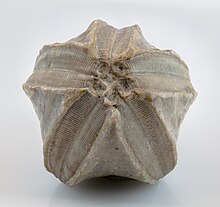
Back براعم البحر Arabic براعم البحر ARZ Blastoideyalar Azerbaijani Blastoïdeus Catalan Blastoidea CEB Knospenstrahler German Blastoidea Spanish Blastoidea Basque غنچههای دریایی Persian Blastoidea French
| Blastoids Temporal range:
| |
|---|---|

| |
| Pentremites godoni, a blastoid from the Lower Carboniferous of Illinois. | |
| Scientific classification | |
| Domain: | Eukaryota |
| Kingdom: | Animalia |
| Phylum: | Echinodermata |
| Subphylum: | †Blastozoa |
| Class: | †Blastoidea Say, 1825 |
| Orders | |
|
Fissiculata | |

Blastoids (class Blastoidea) are an extinct type of stemmed echinoderm, often referred to as sea buds.[1] They first appear, along with many other echinoderm classes, in the Ordovician period, and reached their greatest diversity in the Mississippian subperiod of the Carboniferous period. However, blastoids may have originated in the Cambrian. Blastoids persisted until their extinction at the end of Permian, about 250 million years ago. Although never as diverse as their contemporary relatives, the crinoids, blastoids are common fossils, especially in many Mississippian-age rocks.
- ^ Barnes, Robert D. (1982). Invertebrate Zoology. Philadelphia, PA: Holt-Saunders International. p. 1010. ISBN 0-03-056747-5.